[English] 日本語
 Yorodumi
Yorodumi- PDB-7qnc: Cryo-EM structure of human full-length extrasynaptic alpha4beta3d... -
+ Open data
Open data
- Basic information
Basic information
| Entry | Database: PDB / ID: 7qnc | ||||||||||||||||||
|---|---|---|---|---|---|---|---|---|---|---|---|---|---|---|---|---|---|---|---|
| Title | Cryo-EM structure of human full-length extrasynaptic alpha4beta3delta GABA(A)R in complex with THIP (gaboxadol), histamine and nanobody Nb25 | ||||||||||||||||||
 Components Components |
| ||||||||||||||||||
 Keywords Keywords |  MEMBRANE PROTEIN / pentameric ligand-gated ion channel / MEMBRANE PROTEIN / pentameric ligand-gated ion channel /  neurotransmitter receptor / neurotransmitter receptor /  GABA receptor GABA receptor | ||||||||||||||||||
| Function / homology |  Function and homology information Function and homology information benzodiazepine receptor activity / inhibitory extracellular ligand-gated monoatomic ion channel activity / GABA receptor activation / GABA-gated chloride ion channel activity / cellular response to histamine / benzodiazepine receptor activity / inhibitory extracellular ligand-gated monoatomic ion channel activity / GABA receptor activation / GABA-gated chloride ion channel activity / cellular response to histamine /  inhibitory synapse assembly / inhibitory synapse assembly /  GABA-A receptor activity / GABA-A receptor activity /  GABA-A receptor complex / postsynaptic specialization membrane / GABA-A receptor complex / postsynaptic specialization membrane /  neurotransmitter receptor activity ... neurotransmitter receptor activity ... benzodiazepine receptor activity / inhibitory extracellular ligand-gated monoatomic ion channel activity / GABA receptor activation / GABA-gated chloride ion channel activity / cellular response to histamine / benzodiazepine receptor activity / inhibitory extracellular ligand-gated monoatomic ion channel activity / GABA receptor activation / GABA-gated chloride ion channel activity / cellular response to histamine /  inhibitory synapse assembly / inhibitory synapse assembly /  GABA-A receptor activity / GABA-A receptor activity /  GABA-A receptor complex / postsynaptic specialization membrane / GABA-A receptor complex / postsynaptic specialization membrane /  neurotransmitter receptor activity / neurotransmitter receptor activity /  synaptic transmission, GABAergic / gamma-aminobutyric acid signaling pathway / synaptic transmission, GABAergic / gamma-aminobutyric acid signaling pathway /  chloride channel activity / roof of mouth development / Signaling by ERBB4 / chloride channel activity / roof of mouth development / Signaling by ERBB4 /  chloride channel complex / GABA-ergic synapse / regulation of postsynaptic membrane potential / chloride transmembrane transport / dendrite membrane / transmitter-gated monoatomic ion channel activity involved in regulation of postsynaptic membrane potential / cytoplasmic vesicle membrane / postsynapse / chloride channel complex / GABA-ergic synapse / regulation of postsynaptic membrane potential / chloride transmembrane transport / dendrite membrane / transmitter-gated monoatomic ion channel activity involved in regulation of postsynaptic membrane potential / cytoplasmic vesicle membrane / postsynapse /  postsynaptic membrane / neuron projection / postsynaptic membrane / neuron projection /  axon / neuronal cell body / axon / neuronal cell body /  dendrite / dendrite /  synapse / synapse /  signal transduction / identical protein binding / signal transduction / identical protein binding /  plasma membrane plasma membraneSimilarity search - Function | ||||||||||||||||||
| Biological species |   Homo sapiens (human) Homo sapiens (human)  Lama glama (llama) Lama glama (llama) | ||||||||||||||||||
| Method |  ELECTRON MICROSCOPY / ELECTRON MICROSCOPY /  single particle reconstruction / single particle reconstruction /  cryo EM / Resolution: 2.9 Å cryo EM / Resolution: 2.9 Å | ||||||||||||||||||
 Authors Authors | Sente, A. / Desai, R. / Naydenova, K. / Malinauskas, T. / Jounaidi, Y. / Miehling, J. / Zhou, X. / Masiulis, S. / Hardwick, S.W. / Chirgadze, D.Y. ...Sente, A. / Desai, R. / Naydenova, K. / Malinauskas, T. / Jounaidi, Y. / Miehling, J. / Zhou, X. / Masiulis, S. / Hardwick, S.W. / Chirgadze, D.Y. / Miller, K.W. / Aricescu, A.R. | ||||||||||||||||||
| Funding support |  United Kingdom, 5items United Kingdom, 5items
| ||||||||||||||||||
 Citation Citation |  Journal: Nature / Year: 2022 Journal: Nature / Year: 2022Title: Differential assembly diversifies GABA receptor structures and signalling. Authors: Andrija Sente / Rooma Desai / Katerina Naydenova / Tomas Malinauskas / Youssef Jounaidi / Jonas Miehling / Xiaojuan Zhou / Simonas Masiulis / Steven W Hardwick / Dimitri Y Chirgadze / Keith ...Authors: Andrija Sente / Rooma Desai / Katerina Naydenova / Tomas Malinauskas / Youssef Jounaidi / Jonas Miehling / Xiaojuan Zhou / Simonas Masiulis / Steven W Hardwick / Dimitri Y Chirgadze / Keith W Miller / A Radu Aricescu /    Abstract: Type A γ-aminobutyric acid receptors (GABARs) are pentameric ligand-gated chloride channels that mediate fast inhibitory signalling in neural circuits and can be modulated by essential medicines ...Type A γ-aminobutyric acid receptors (GABARs) are pentameric ligand-gated chloride channels that mediate fast inhibitory signalling in neural circuits and can be modulated by essential medicines including general anaesthetics and benzodiazepines. Human GABAR subunits are encoded by 19 paralogous genes that can, in theory, give rise to 495,235 receptor types. However, the principles that govern the formation of pentamers, the permutational landscape of receptors that may emerge from a subunit set and the effect that this has on GABAergic signalling remain largely unknown. Here we use cryogenic electron microscopy to determine the structures of extrasynaptic GABARs assembled from α4, β3 and δ subunits, and their counterparts incorporating γ2 instead of δ subunits. In each case, we identified two receptor subtypes with distinct stoichiometries and arrangements, all four differing from those previously observed for synaptic, α1-containing receptors. This, in turn, affects receptor responses to physiological and synthetic modulators by creating or eliminating ligand-binding sites at subunit interfaces. We provide structural and functional evidence that selected GABAR arrangements can act as coincidence detectors, simultaneously responding to two neurotransmitters: GABA and histamine. Using assembly simulations and single-cell RNA sequencing data, we calculated the upper bounds for receptor diversity in recombinant systems and in vivo. We propose that differential assembly is a pervasive mechanism for regulating the physiology and pharmacology of GABARs. | ||||||||||||||||||
| History |
|
- Structure visualization
Structure visualization
| Structure viewer | Molecule:  Molmil Molmil Jmol/JSmol Jmol/JSmol |
|---|
- Downloads & links
Downloads & links
- Download
Download
| PDBx/mmCIF format |  7qnc.cif.gz 7qnc.cif.gz | 363.1 KB | Display |  PDBx/mmCIF format PDBx/mmCIF format |
|---|---|---|---|---|
| PDB format |  pdb7qnc.ent.gz pdb7qnc.ent.gz | 299 KB | Display |  PDB format PDB format |
| PDBx/mmJSON format |  7qnc.json.gz 7qnc.json.gz | Tree view |  PDBx/mmJSON format PDBx/mmJSON format | |
| Others |  Other downloads Other downloads |
-Validation report
| Arichive directory |  https://data.pdbj.org/pub/pdb/validation_reports/qn/7qnc https://data.pdbj.org/pub/pdb/validation_reports/qn/7qnc ftp://data.pdbj.org/pub/pdb/validation_reports/qn/7qnc ftp://data.pdbj.org/pub/pdb/validation_reports/qn/7qnc | HTTPS FTP |
|---|
-Related structure data
| Related structure data |  14074MC 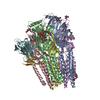 7qn5C  7qn6C  7qn7C  7qn8C 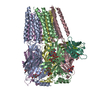 7qn9C 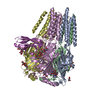 7qnaC  7qnbC 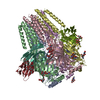 7qndC  7qneC M: map data used to model this data C: citing same article ( |
|---|---|
| Similar structure data | Similarity search - Function & homology  F&H Search F&H Search |
| EM raw data |  EMPIAR-10910 (Title: Cryo-EM micrographs of GABA(A)Rs purified from cells expressing human full-length alpha4, beta3 and delta subunits, in presence of THIP (gaboxadol), histamine and nanobody Nb25 EMPIAR-10910 (Title: Cryo-EM micrographs of GABA(A)Rs purified from cells expressing human full-length alpha4, beta3 and delta subunits, in presence of THIP (gaboxadol), histamine and nanobody Nb25Data size: 3.8 TB Data #1: Unaligned multi-frame micrographs of GABA(A) receptors purified from cells expressing alpha4, beta3 and delta subunits, in presence of THIP (gaboxadol), histamine and nanobody Nb25 [micrographs - multiframe]) |
- Links
Links
- Assembly
Assembly
| Deposited unit | 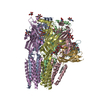
|
|---|---|
| 1 |
|
- Components
Components
-Gamma-aminobutyric acid receptor subunit ... , 3 types, 5 molecules ABCDE
| #1: Protein | Mass: 61696.047 Da / Num. of mol.: 1 Source method: isolated from a genetically manipulated source Source: (gene. exp.)   Homo sapiens (human) / Gene: GABRA4 / Cell line (production host): HEK293S TetR / Production host: Homo sapiens (human) / Gene: GABRA4 / Cell line (production host): HEK293S TetR / Production host:   Homo sapiens (human) / References: UniProt: P48169 Homo sapiens (human) / References: UniProt: P48169 | ||
|---|---|---|---|
| #2: Protein | Mass: 54180.348 Da / Num. of mol.: 3 Source method: isolated from a genetically manipulated source Source: (gene. exp.)   Homo sapiens (human) / Gene: GABRB3 / Cell line (production host): HEK293S TetR / Production host: Homo sapiens (human) / Gene: GABRB3 / Cell line (production host): HEK293S TetR / Production host:   Homo sapiens (human) / References: UniProt: P28472 Homo sapiens (human) / References: UniProt: P28472#3: Protein | | Mass: 52437.926 Da / Num. of mol.: 1 Source method: isolated from a genetically manipulated source Source: (gene. exp.)   Homo sapiens (human) / Gene: GABRD / Cell line (production host): HEK293S TetR / Production host: Homo sapiens (human) / Gene: GABRD / Cell line (production host): HEK293S TetR / Production host:   Homo sapiens (human) / References: UniProt: O14764 Homo sapiens (human) / References: UniProt: O14764 |
-Antibody , 1 types, 2 molecules FG
| #4: Antibody | Mass: 13341.741 Da / Num. of mol.: 2 Source method: isolated from a genetically manipulated source Source: (gene. exp.)   Lama glama (llama) / Production host: Lama glama (llama) / Production host:   Escherichia coli (E. coli) Escherichia coli (E. coli) |
|---|
-Sugars , 3 types, 13 molecules 
| #5: Polysaccharide | alpha-D-mannopyranose-(1-3)-[alpha-D-mannopyranose-(1-6)]beta-D-mannopyranose-(1-4)-2-acetamido-2- ...alpha-D-mannopyranose-(1-3)-[alpha-D-mannopyranose-(1-6)]beta-D-mannopyranose-(1-4)-2-acetamido-2-deoxy-beta-D-glucopyranose-(1-4)-2-acetamido-2-deoxy-beta-D-glucopyranose  / Mass: 910.823 Da / Num. of mol.: 4 / Mass: 910.823 Da / Num. of mol.: 4Source method: isolated from a genetically manipulated source #6: Polysaccharide |  / Mass: 424.401 Da / Num. of mol.: 3 / Mass: 424.401 Da / Num. of mol.: 3Source method: isolated from a genetically manipulated source #7: Sugar | ChemComp-NAG /  N-Acetylglucosamine N-Acetylglucosamine |
|---|
-Non-polymers , 3 types, 7 molecules 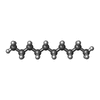




| #8: Chemical |  Decane Decane#9: Chemical |  Gaboxadol Gaboxadol#10: Chemical |  Histamine Histamine |
|---|
-Details
| Has ligand of interest | Y |
|---|
-Experimental details
-Experiment
| Experiment | Method:  ELECTRON MICROSCOPY ELECTRON MICROSCOPY |
|---|---|
| EM experiment | Aggregation state: PARTICLE / 3D reconstruction method:  single particle reconstruction single particle reconstruction |
- Sample preparation
Sample preparation
| Component | Name: Human full-length extrasynaptic alpha4beta3delta GABA(A)R in complex with THIP (gaboxadol), histamine and nanobody Nb25 Type: COMPLEX / Entity ID: #1-#4 / Source: RECOMBINANT | |||||||||||||||
|---|---|---|---|---|---|---|---|---|---|---|---|---|---|---|---|---|
| Source (natural) | Organism:   Homo sapiens (human) Homo sapiens (human) | |||||||||||||||
| Source (recombinant) | Organism:   Homo sapiens (human) / Cell: HEK293S TetR Homo sapiens (human) / Cell: HEK293S TetR | |||||||||||||||
| Buffer solution | pH: 7.6 | |||||||||||||||
| Buffer component |
| |||||||||||||||
| Specimen | Embedding applied: NO / Shadowing applied: NO / Staining applied : NO / Vitrification applied : NO / Vitrification applied : YES : YES | |||||||||||||||
Vitrification | Instrument: LEICA PLUNGER / Cryogen name: ETHANE / Humidity: 95 % / Chamber temperature: 287 K |
- Electron microscopy imaging
Electron microscopy imaging
| Experimental equipment |  Model: Titan Krios / Image courtesy: FEI Company |
|---|---|
| Microscopy | Model: FEI TITAN KRIOS |
| Electron gun | Electron source : :  FIELD EMISSION GUN / Accelerating voltage: 300 kV / Illumination mode: FLOOD BEAM FIELD EMISSION GUN / Accelerating voltage: 300 kV / Illumination mode: FLOOD BEAM |
| Electron lens | Mode: BRIGHT FIELD Bright-field microscopy / Nominal magnification: 130000 X / Nominal defocus max: 2100 nm / Nominal defocus min: 700 nm / Cs Bright-field microscopy / Nominal magnification: 130000 X / Nominal defocus max: 2100 nm / Nominal defocus min: 700 nm / Cs : 2.7 mm / C2 aperture diameter: 50 µm / Alignment procedure: COMA FREE : 2.7 mm / C2 aperture diameter: 50 µm / Alignment procedure: COMA FREE |
| Specimen holder | Cryogen: NITROGEN |
| Image recording | Electron dose: 40 e/Å2 / Film or detector model: GATAN K3 (6k x 4k) |
| EM imaging optics | Energyfilter name : GIF Bioquantum / Energyfilter slit width: 20 eV : GIF Bioquantum / Energyfilter slit width: 20 eV |
- Processing
Processing
| Software | Name: PHENIX / Version: 1.19.2_4158: / Classification: refinement | ||||||||||||||||||||||||||||||||||||||||
|---|---|---|---|---|---|---|---|---|---|---|---|---|---|---|---|---|---|---|---|---|---|---|---|---|---|---|---|---|---|---|---|---|---|---|---|---|---|---|---|---|---|
| EM software |
| ||||||||||||||||||||||||||||||||||||||||
CTF correction | Type: PHASE FLIPPING AND AMPLITUDE CORRECTION | ||||||||||||||||||||||||||||||||||||||||
3D reconstruction | Resolution: 2.9 Å / Resolution method: FSC 0.143 CUT-OFF / Num. of particles: 61854 / Symmetry type: POINT | ||||||||||||||||||||||||||||||||||||||||
| Atomic model building | Protocol: AB INITIO MODEL | ||||||||||||||||||||||||||||||||||||||||
| Refine LS restraints |
|
 Movie
Movie Controller
Controller











 PDBj
PDBj








